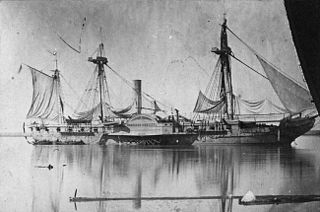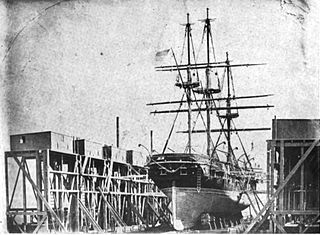USS Vesuvius was a 239-ton steamer acquired by the United States Navy for use during the Mexican–American War which was an armed military conflict between the United States and Mexico from 1846 to 1848 in the wake of the 1845 U.S. annexation of Texas.

The Home Squadron was part of the United States Navy in the mid-19th century. Organized as early as 1838, ships were assigned to protect coastal commerce, aid ships in distress, suppress piracy and the Atlantic slave trade, make coastal surveys, and train ships to relieve others on distant stations. It was discontinued in 1861 after the outbreak of the American Civil War, when the Union blockade forced a reassignment of ships to close off Southern ports.

Henry Walke was an officer in the United States Navy during the Mexican–American War and the American Civil War.
USS Germantown was a United States Navy sloop-of-war in commission for various periods between 1847 and 1860. She saw service in the Mexican–American War in 1847–1848 and during peacetime operated in the Caribbean, in the Atlantic Ocean off Africa and South America, and in East Asia. Scuttled at the outbreak of the American Civil War in 1861, she was captured and refloated by the Confederate States of America and placed in service with the Confederate States Navy as the floating battery CSS Germantown before again being scuttled in 1862.

The second USS St. Mary's was a sloop-of-war in the United States Navy.
Henry A. Clemson was an officer in the United States Navy in the early 19th century. Clemson died at sea during the Mexican American War (1846) and was memorialized on the Mexican War Midshipmen's Monument and the naming of a naval destroyer, USS Clemson (DD-186).

The third USS Vixen was a steamboat in the United States Navy during the Mexican–American War.

USS Albany, the first United States Navy ship of that name, was built in the 1840s for the US Navy. The ship was among the last of the wooden sloops powered by sail and saw extensive service in the Mexican War. Before and after her combat service, Albany conducted surveillance and observation missions throughout the Caribbean. In September 1854, during a journey along the coast of Venezuela, Albany was lost with all hands on 28 or 29 September 1854. Included among the 250 men lost were several sons and grandsons of politically prominent men.

USS Scourge was a steamer warship in service during the Mexican–American War (1846–1848). She was the third United States Navy ship of that name.

The Second Battle of Tabasco, also known as the Battle of Villahermosa, was a battle fought in June 1847 during the Mexican–American War as part of the U.S. blockade of Mexican Gulf ports.

The First Battle of Tabasco was fought during the Mexican–American War, in October 1846, in an attempt to capture cities along the Tabasco coast.

USS Fulton was a steamer that served the U.S. Navy prior to the American Civil War, and was recommissioned in time to see service in that war. However, her participation was limited to being captured by Confederate forces in the port of Pensacola, Florida, at the outbreak of war.
USS Water Witch was a steamer in the service of the United States Navy. She participated in the Mexican–American War which lasted from 1846 to 1848.
USS Fredonia was an 800-ton bark that served the U.S. Navy as a transport and as a storeship. After several voyages to California by way of Cape Horn, she became the station warehouse in Arica, where she was destroyed by an earthquake.
USRC Walter Forward was a schooner constructed for service with the United States Revenue Marine. She was more commonly known as USRC Forward. Forward served with the U.S. Army and U.S. Navy in Mexican waters during the Mexican–American War and was commended for her actions during the Tabasco River landings by Commodore Matthew C. Perry, U.S. Navy. After the war, she was transferred to the U.S. Coast Survey for a short time as USCS Walter Forward before being returned to the Revenue Marine for service during the 1850s and the American Civil War.

The Battle of Antón Lizardo was a naval engagement of the Mexican civil war between liberals and conservative governments, the Reform War. It took place off the Gulf Coast town of Antón Lizardo, Mexico in 1860. A Mexican Navy officer, Rear Admiral Tomás M. Marín, mutinied and escaped to Havana, Cuba. There he formed a squadron of armed vessels to attack merchant ships and blockade Veracruz. The liberal Mexican Government of Benito Juárez declared Tomás Marín a pirate and permitted foreign navies to attack his ships. Juárez's government was supported by the United States and its navy already had several vessels patrolling in the Gulf of Mexico.
USS Petrita was a steamer that served in the United States Navy from 1846 to 1848. She saw service in the Mexican War.

Rear Admiral George Henry Cooper was an officer in the United States Navy. During his long naval career, he served on the African Slave Trade Patrol, and fought in the Second Seminole War, the Mexican War, the American Civil War, and the Korean Expedition, and rose to command of the North Atlantic Squadron.
USS Reefer, was a pilot schooner purchased by the United States Navy at New York City on May 25, 1846 from shipbuilders Brown & Bell for service as a dispatch boat in Commodore David Conner's Home Squadron during the Mexican–American War.










